How did
the form of Sri Lakshmi evolve over millennia? Plus Sri Lakshmi in texts, on
coins and seals.
Sri or Lakshmi- the goddess of wealth and
prosperity. The most sought after devi especially for homemakers and those in
trade and commercial activities. She is also among the earliest represented
deities in Indian iconography in the form of Gaja Lakshmi.
SRI-LAKSHMI IN TEXTSRig Veda uses the term Sri both as a noun and
adjective to denote anything that appears as beautiful, which includes wealth
and prosperity; while as a verb it is used in the connection of mixing milk
with soma where the former adds to beauty or taste of the latter (enhancement).
The Brahmanas first personifies Sri, where she takes the form
of a beautiful woman and appears from the ascetic Prajapati.
The term Lakshmi in Rigveda refers
to auspicious qualities, and in later Vedic literature Sri and Lakshmi appear
together denoting loveliness. In Srisukta (pre Buddhist
period) Sri and Lakshmi are considered as one devi who is padmasthita or
stands on the lotus. In Taittiriya Upanishad Sri gives cows,
food, drinks, and clothes; hence Sri should be brought home. In the Sutras,
Sri is given offerings as the head of the bed, denoting her associations with
the fertility rituals and mother goddesses.
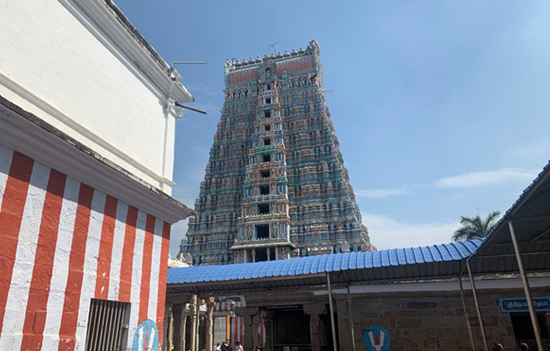 Padmastitha, Gaja-Lakshmi. Terracotta. Uttar Pradesh. 1st
century BCE. Los Angeles County Museum of Art.
Padmastitha, Gaja-Lakshmi. Terracotta. Uttar Pradesh. 1st
century BCE. Los Angeles County Museum of Art.
While the association of
Sri-Lakshmi with Vishnu starts with the Epics, interestingly a look at the
Vedic verses dedicated to Aditi shows her as the Mother of the Universe and the
wife of the Vedic Vishnu (Yajur Veda). She is sometimes identified as the Earth, who
is worshipped for wealth and prosperity; and sometimes she is referred to as a
milk giving cow whose milk is equal to the heavenly soma.
Thus, it is clear that
Aditi as the Universal Mother and the Lady of Abundance of the Vedas bears
resemblances to the later period consorts of Vishnu: Bhu devi and Sri-Lakshmi.
Thus, Sri is the Mother (from an inscription found at Bharhut, and some later
sculptures showing her pressing milk from her breast), and at the same time as
per later Vaishnava theology, she is also Prakriti, keeping in line with
Narayana (Vishnu) as the Purusha or spirit.
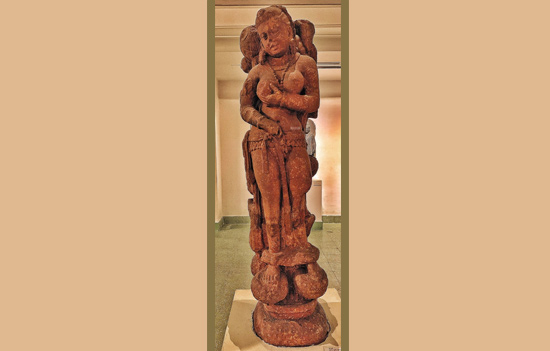 One of the most beautiful representations of Sri-Lakshmi as the Mother (front side). Kushana
period, 2nd c. CE, Mathura.
One of the most beautiful representations of Sri-Lakshmi as the Mother (front side). Kushana
period, 2nd c. CE, Mathura.
Besides Aditi in Yajur Veda, the early Samhita texts have names of other devis of abstract
characters, which remind one of Sri-Lakshmi of the later period. Purandhi (many
regard her as the Vedic form of Avestan Parendi) is the goddess of plenty,
while Raka is portrayed as a rich and beautiful devi. Sinivali is mentioned in Atharvaveda VIII as Vishnu’s wife, who is fair, prolific, and
invoked for bearing children.
In the later Vedic texts
Raka and Sinivali become connected with the different phases of the moon, where
Raka is the presiding deity of the purnima (full moon) night, and Sinivali is
the deity of the new moon night (amavasya). The Brahmana text (Sathpatha Brahmana) gives an interesting story regarding the origin
of Sri, where it states that when Prajapati became tired of creating beings,
Sri came forth from him. The gods seeing her perfect and radiant beauty were
envious and wanted to kill her; however Prajapati intervened and asked the gods
to take away her attributes and spare her life.
The gods thus took from
her: food, kingdom, sovereignty, noble rank, power, holy shine, dominion,
wealth, prosperity, and beauty. Later the devi offered 10 sacrificial dishes to
the 10 gods who had taken away her attributes, and had everything offered back
to her. The underlying point of this story is that Sri embodies all the major
characteristics that are coveted by man. The Taittiriya Upanishad (I) and other texts also emphasize on these
characteristics of the devi, while Sri-sukta ( a late supplement of the Rigveda) gives 15
verses defining the most distinctive features of the devi, and it is here that
Sri is also named as Lakshmi, and is described as a golden colored antelope
with gold and and silver garlands.
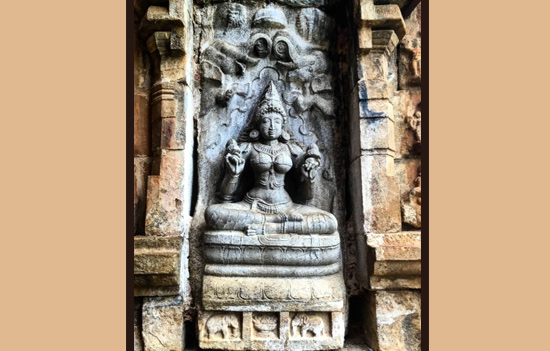 Gaja Lakshmi, Gangaikondacholapuram, 11th century
CE.
Gaja Lakshmi, Gangaikondacholapuram, 11th century
CE.
It is in the Epics that Sri-Lakshmi takes a firm shape as the goddess
of wealth and prosperity, and is associated with kings and gods. Here
Sri clearly stands for prosperity, perseverance, and success: the
characteristics of victorious kings. In the Mahabharata and VishnuPurana Sri-Lakshmi is said to have been born out of
the churning waters of the Ocean during Samudramanthan
(her association with the waters has always been implied by the presence of
lotus in her hands or around her).
She is the wife of Vishnu
and also the wife of Dharma; and the mother of Kamadeva (as the mother of
Makaradhvaja or Kamdev she carries the sign of makara on her hand in Mahabharata xiii, 11, 3). She is also Rukmini, the chief
consort of Krishna and the mother of his son Pradyumna.
As wife of Dharma, Sri is
shown separate from Lakshmi, and in Mahabharata she is associated with abstract
forms such as Pusti, Hri, Uma, Sarasvati, Kirti, Dyuti, etc.; however barring
this exception, Sri and Lakshmi are seen as one entity. Radha in connection
with Krishna is also seen as the manifestation of Sri-Lakshmi in human form, in
whom we find prem ras or love idealised and perfected. Some verses in the
Mahabharata have also closely associated Kubera with Sri-Lakshmi and this
ideological union between the goddess of prosperity and the god of wealth is
easily understandable.
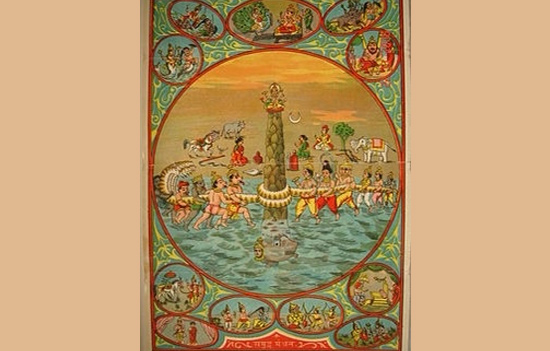 Sri Lakshmi coming out of the ocean during
Samudramanthan.
Sri Lakshmi coming out of the ocean during
Samudramanthan.
In Buddhist texts Sri is given less importance, and
is casually mentioned in many places as devakumarika; the devi who bestows
fortune and beauty, and is associated with the northern and southern quarters.
In Jataka 535 and in Kadambari, the devi is reproached for her fickleness,
unstable nature, and the willingness to indiscriminately bestow fortune on the
lazy, ugly, and the lowborn, along with the hardworking, wise, and the high
born. In Japanese Buddhism Sri-Lakshmi is
the daughter of Hariti, hence a yakshi.
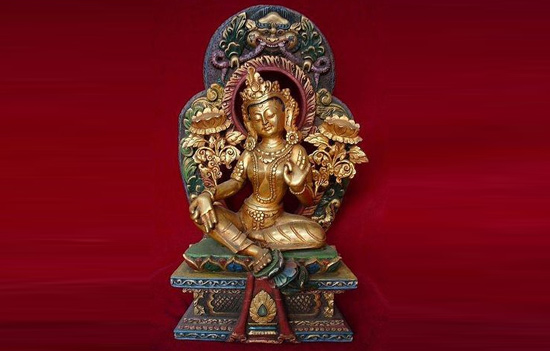 Buddhist Sri Lakshmi.
Buddhist Sri Lakshmi.
In Jaina literature, Sri-Lakshmi finds more
importance, and in Paryusana Kalpa the abhiseya of Sri is one of the 14
auspicious dreams of Trisala (mother of Mahavira), which foretells the birth of
this great Jina. The detailed description of it paints a fine imagery of the
abhiseya, where Sri- Lakshmi of great physical beauty wearing a garland of gold
coins (dinaras) rests on a lotus in a lotus pond amidst the surrounding peaks
of the Himalaya, as the trunks of two elephants pour water on her.
In the much later Jaina
text Parisistaparvan, we find Sri devi described as holding a lotus
and residing in Padmahrada in the Himalaya.
 Lakshmi in modern Bengal art, Owl
as her vahana was a much later addition.
Lakshmi in modern Bengal art, Owl
as her vahana was a much later addition.
Sri-Lakshmi in Iconography.From the various available literature one
characteristic that is seen constantly associated with Sri- Lakshmi is that of
the presence of waters, symbolically represented by lotus. According to
Coomaraswamy there are three varieties of
Sri-Lakshmi:
1. She is seen carrying a lotus in her right hand,
while her left hand hangs freely or rests on her hips in katihasta mudra (Padmahasta)
2. Shown as seated or standing on a lotus seat or
pedestal (Padmasana or Padmapitha)
3. Surrounded by lotus foliage, where the devi is sometimes
seen holding one of the flowering stems in each hand (Padmavasini or Kamalalaya).
These may appear as
separate or the three or two may be combined together in a murti. While the
first two representations are also seen in yaksis, the third one is the most
distinctive feature of the early representations of the devi.
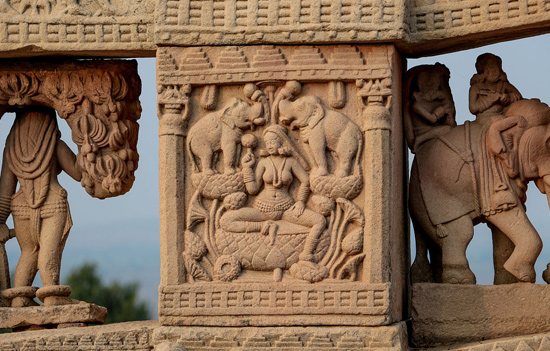 Padmahasta, Padmasana. Padmavasini.
Padmahasta, Padmasana. Padmavasini.
Full caption-Bas
relief of Gaja Lakshmi at the Sanchi Stupa, Stupa I, North
gateway, Satavahana dynasty sculpture, 1st century CE. Lotus
symbolizes water and Sri is always associated with lotus and waters.
Iconographic studies by
TAG Rao shows that Sri Lakshmi can be two-four or even many armed; however the
most common variety is the two armed form. In her arms are seen the various
attributes, such as lotus (the constant attribute), sriphala or wood apple
(bael), sankha, amritaghata, matulunga (citron), khetaka (shield), kaumodiki
(club), etc.
As per the Viswakarmasastra, Mahalakshmi in Kolhapur carries a pot, a club, a
shield and wood apple. Candikalpa, which is a supplementary to Devi Mahatmya, describes the devi with 18 arms carrying
japmala, hatchet, club, arrow, vajra, padma, bow, kundika (small pitcher),
staff, spear, sword, shield, bell, and winecup.
The imagery depiction of
Sri Lakshmi in earliest form of Indian iconographic art has followed various
modes. In Bharhut there is a magnificent pillar relief depicting a standing
female figure in samapadasthanaka
posture with her right hand holding a flower, (as per Coomaraswamy it is a
lotus), while her left hand hangs by her side. This figure is inscribed as
Sirima devta, the goddess Mother Sri (as per Sirikalakanni Jataka).
The variants of Sirima
devta is seen across Sanchi, Bodh Gaya, etc. where sometimes the background
changes showing a padmavana (a lotus forest). Sometimes a makara is also seen
associated with the devi, as seen in a fragmentary coping stone from Amaravati
of 2nd c. CE (makara being a mythical water creature and symbolising fertility;
and as also the mother of Makaradhvaja or Kamdev). The much mutilated female
figure which was found by Cunningham along with the Besnagar kalpataru capital
is also that of Sri Lakshmi as identified by Banerjea. A rather unique form of
the devi is seen from the Mauryan-Sunga period, as in terracotta figurines (one
such is seen in Spooner’s list, number 550) where she is represented with
unusual wings, heavy earrings, heavy bracelets, torque, and archaic styled
costume.
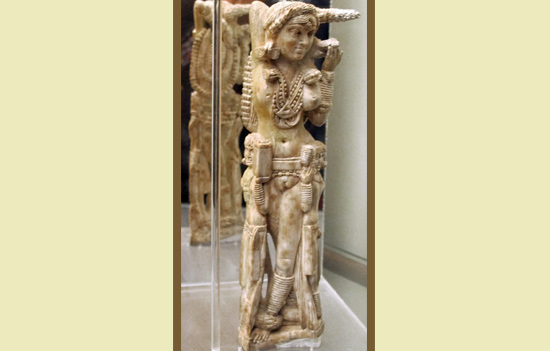 Famous Pompeii Lakshmi (ivory murti)
Famous Pompeii Lakshmi (ivory murti)
Full caption-The famous
Pompeii Lakshmi (ivory murti) was found amidst the ruins of Pompeii
and is said to have come from Bhokardan in Maharashtra during the
Satavahana period (first half of the 1st c. CE). It stands as a testimony of
the thriving Indo-Roman trade relations in the beginning of the
Common Era. Photo source Wikipedia.
Sri-Lakshmi
on coins
Sri-Lakshmi is one of the earliest deities in
Indian iconography to be found frequently on tribal coins as Gaja Lakshmi,
where she is shown standing (rarely seated) being bathed by two elephants. This
devi was so popular that she is seen on the coins of both Indian and non-native
rulers of northern India in ancient era. Gaja Lakshmi appears on an inscribed
coin from 3rd c. BCE coin found in Kausambi, coins of Ujjayini (2nd-3rd c.
BCE), coins of Visakhadeva, Sivadatta, and Vayudeva of Ayodhya (1st c. BCE).
Many rulers of foreign origin like Azilises,
Rajuvala, and Sodasa also used this devi as a motif on their coins. In central
Indian many early monuments show the devi in this form in their relief
carvings, thus showing a close connection between the sculptural and numismatic
representations of the devi. This motif (gaja-Lakshmi)
symbolises the Indian idea of prosperity and wealth, and is still held
in great reverence among the Indics.
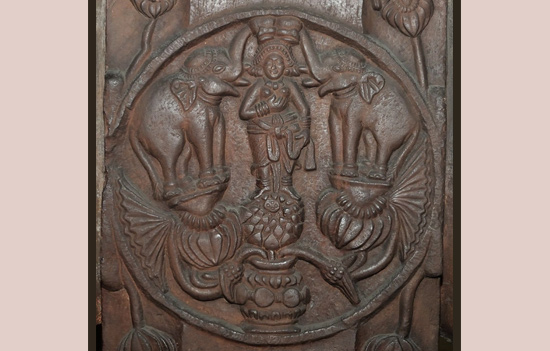 Gajalaxmi-Medallion-2nd Century BCE.
Gajalaxmi-Medallion-2nd Century BCE.
Full caption-Red Sand Stone, Bharhut Stupa Railing Pillar, Madhya Pradesh- Indian Museum – Kolkata. From Wikipedia.
Sri Lakshmi without the elephants, either seated or
standing on a fully blossomed lotus holding lotus in her hand is seen
frequently on the coins of Ujjayini of various Hindu kings, such as
Brahmamitra, Suryamitra, Vishnumitra, etc. Her hand is frequently seen in the
coins of the Mathura satraps such as Sivadatta, Rajuvala etc., on coins of
Rajanya janapada, and coins of Bhadraghosa (Pancala). Sri Lakshmi also appears
on the coins of the Gupta kings in various forms (one of which is an exact
Indian counterpart of the foreign origin goddess Ardochso), and is a constant
on the coins from later periods.
Sri Lakshmi
on seals
The Gupta period has yielded many finely executed
seals that bear Gaja Lakshmi as the motif (in her various forms). The copper
plate seal of the Kumaramatyadhikarana (early Gupta period)
shows Gaja Lakshmi standing among trees with elephants pouring water over her
and two dwarfs attendants (yakshas) holding money bags. This form has many
variations on seals, where sometimes the yaksha attendants are missing, and in
some they are shown pouring out the objects in the bag, and in one there is a
kneeling attendant. These money bags are the same as the one we see at the base
of the Kalpataru found at Besnagar.
In another seal found at Basarh by Spooner (seal
no. 93) has the devi shown with a halo behind her, facing front, her left hand
on her hip and right hand raised, standing on a pedestal placed on the centre
of what looks like a barge, justifying the devi’s close association with trade
and commerce (vanjiye vasate Laksmih). Among the seals found from Bhita
(another Gupta period site) of Sri Lakshmi, the most frequently found is that
of her in the Gaja Lakshmi form, shown sometimes with a chakra like motif and
named Vishnurakshita, sometimes with
the yakshas, with a sankha, or a bird like creature likely to be Garuda.
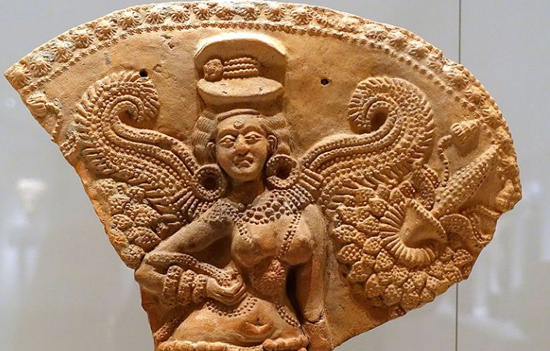 Winged Mother goddess/Lakshmi in terracotta.
Winged Mother goddess/Lakshmi in terracotta.
Full caption-Winged Mother goddess/Lakshmi in terracotta, Sunga
dynasty, Chandraketugarh, West Bengal, 2nd-1st century B.C, Ethnological
Museum, Berlin. Photo from the internet.
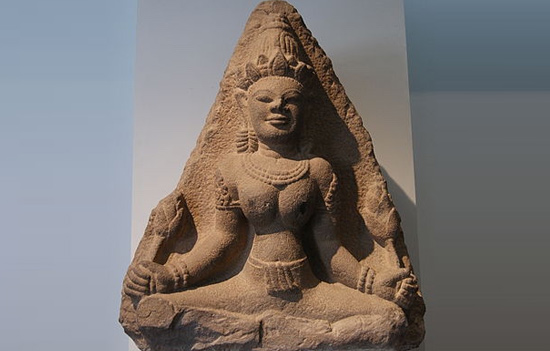 Sandstone Lakshmi statue (10th century), Museum of Vietnamese History, Ho Chi Minh City.
Sandstone Lakshmi statue (10th century), Museum of Vietnamese History, Ho Chi Minh City.
 Gajalakshmi, Cave No. 16 (Kailasa Temple),
Ellora Caves.
Gajalakshmi, Cave No. 16 (Kailasa Temple),
Ellora Caves.
References
1. Kiran Kumar Thaplyal. OBSERVATIONS ON SOME
DOUBLE AND MULTIPLE SEALS AND SEAL-IMPRESSIONS. Proceedings of the Indian
History Congress, Vol. 33 (1971), pp. 35-38 (4 pages).
Published by: Indian History Congress.
2. TAG Rao, Elements of Hindu iconography
3. Sivaramamurti, Goddess Lakshmi and her
symbols
4. Banerjea, Padmini Vidya, 1941
5. Coomaraswamy, Early Indian Iconography.
To read all articles by author
Author studies
life sciences, geography, art and international relationships. She loves
exploring and documenting Indic Heritage. Being a student of history she likes
to study the iconography behind various temple sculptures. She is a well-known columnist
- history and travel writer. Or read here
Article
was first published on author’s blog and Here Article and
pictures are courtesy and copyright author.